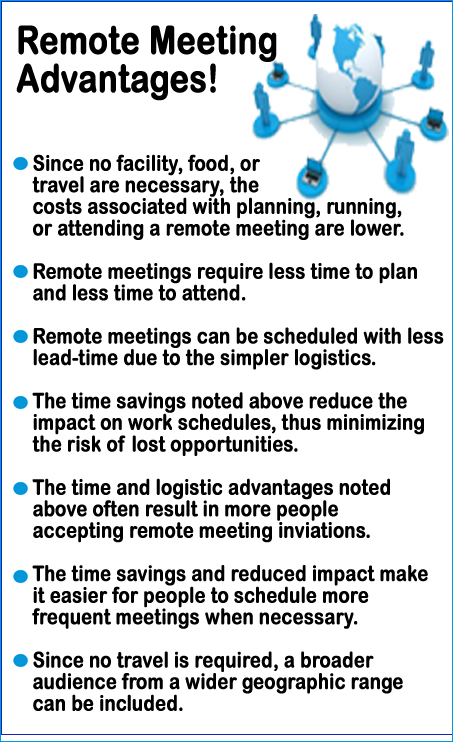People often say it can be difficult to stay focused during remote or virtual team meetings because there is little or no visual contact between the parties. Others tend to multi-task, which also compromises their ability to focus; and their consequential failure to actively participate or respond to questions frequently diminishes the experience for other attendees. Technical difficulties can negatively impact remote sessions as well, as can improper use of communication platforms.
Given these challenges, one might conclude that virtual forms are not productive.
But the many advantages associated with virtual meetings far outweigh the disadvantages, as shown in the text box. In addition, there are techniques that enable meeting leaders to eliminate or minimize the negatives and transform remote meetings into productive and
positive experiences.

These best practices apply to any type of staff or project team meeting, and can be separated into four categories:
Strategic Preparation. A strong leader who plans and uses an agenda and who communicates proactively is a must. The leader should plan for these sessions to be more interactive than in-person meetings. This will require modifying the planning process to include both “speaking points” and questions. For the best remote meetings, the leader must make strategic use of open-ended and closed-ended questions to engage participants and to promote or more closely manage the discussion.
Once the plan is complete the next step involves effectively running the remote session. The leader should call-in or log-in a few minutes early and greet participants as they arrive, thus beginning the engagement process. During these early minutes it’s best to ask questions about subjects that are NOT on the meeting’s agenda. The goal is to connect with the individuals, make them feel comfortable and promote their active participation in the remote meeting.
It’s important to start on time, even if everyone has failed to call in or join. If people join late, it’s appropriate to offer a brief welcome but continue with the meeting’s discussion. Stopping to bring late-comers up to speed will diminish the experience for other participants and indirectly encourages the wrong behavior.
Open with a brief roll call (a good way to test audio) and then identify ground-rules with respect to cell phone use, a disconnect plan, how questions will be handled, general etiquette, and how people should use tools such as chat, mute, etc. Then make a clear statement of the meeting’s objectives.
From this point forward, the leader should promote an appropriate level of interaction by incorporating questions into the discussion. As a rule of thumb, two-to-four times as many questions than might be posed in a face-to-face meeting. It’s best to direct these questions to individuals by name and avoid questions that are directed to the entire group, such as, “Does anybody have a question?” While it is common and acceptable to pose questions to the entire group in a live meeting, it is far less effective in a virtual meeting. The reason for this is simple: the visual contact in a live meeting allows everyone to easily see who has a question or who wishes to be heard. But in a remote forum, the most common result of “group-directed” questions is confusion; either no one says anything because no one is sure whose turn it is to speak, or several people pose questions or offer input at the same time.
Ending the session properly will yield greater productivity. At the end of many remote meetings participants simply hang-up or disconnect without drawing conclusions or setting next steps.
As the meeting leader, you can avoid this “flat” ending and also improve the session’s productivity by conducting a formal wrap-up a few minutes prior to the meeting’s scheduled conclusion. Be sure to leave sufficient time for this!
Follow-up is the last, but certainly not the least important, step. As the meeting leader, there are several ways to promote productive outcomes and to hold people accountable for completing agreed-upon or assigned tasks.
These simple (but not always easy) tasks include distributing a short meeting summary confirming next steps, proactively reaching out to participants after-the-fact to offer support for completing assigned or agreed-upon tasks, and doing whatever it might be that you committed to doing during the session!